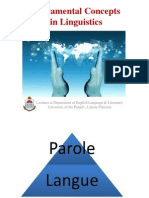0% found this document useful (0 votes)
9 views5 pagesAss EnglishLanguageSystem
The document provides an overview of the English language system, defining language as a complex communication system that evolves with culture and technology. It discusses the roles of phonetics, phonology, morphology, syntax, semantics, and pragmatics in language production, perception, and meaning. Additionally, it highlights the importance of these components in understanding language structure and social interaction.
Uploaded by
Solomon SolisCopyright
© © All Rights Reserved
We take content rights seriously. If you suspect this is your content, claim it here.
Available Formats
Download as DOCX, PDF, TXT or read online on Scribd
0% found this document useful (0 votes)
9 views5 pagesAss EnglishLanguageSystem
The document provides an overview of the English language system, defining language as a complex communication system that evolves with culture and technology. It discusses the roles of phonetics, phonology, morphology, syntax, semantics, and pragmatics in language production, perception, and meaning. Additionally, it highlights the importance of these components in understanding language structure and social interaction.
Uploaded by
Solomon SolisCopyright
© © All Rights Reserved
We take content rights seriously. If you suspect this is your content, claim it here.
Available Formats
Download as DOCX, PDF, TXT or read online on Scribd
/ 5






















































































